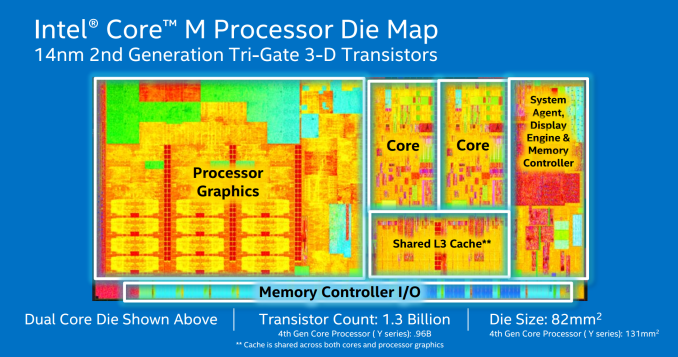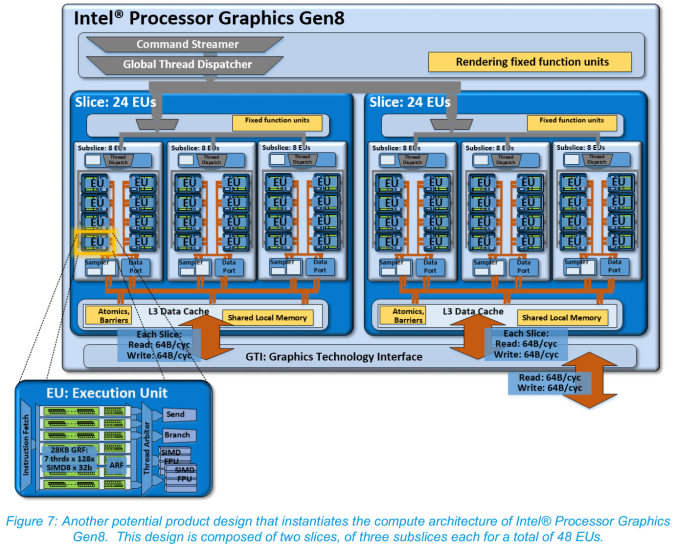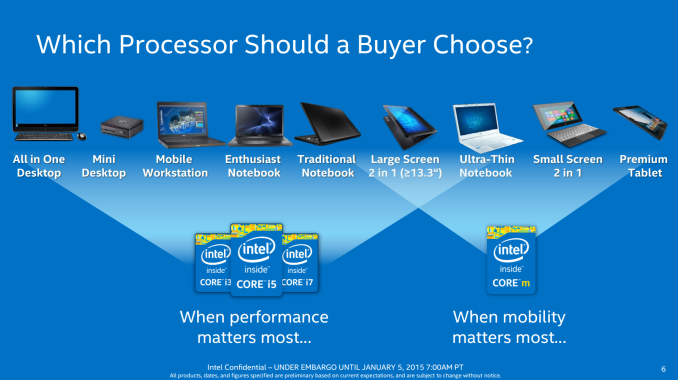Analyzing Intel Core M Performance: How 5Y10 can beat 5Y71 & the OEMs' Dilemma
by Brett Howse & Ian Cutress on April 8, 2015 8:00 AM EST
A processor architect can battle between two major opposing principles. The one most of us seem to enjoy is performance, which when taken to the extreme exhibits an all-or-nothing approach. At the other end is low-power operation which has become the main focus of the laptop and notebook market where battery capacity and density is at a premium. The position in the middle of this is efficiency, trying to extract the best of performance and power consumption and provide a product at the end of the day which attempts to satisfy both.
Of course processor architects only have control up to the point where the chips leave the fab, at which point the final product design is in the hands of OEMs, who for various reasons will have their own product design goals. It's this latter point that has resulted in an interesting situation developing around the Core M ecosystem, where due to OEM design goals we've seen the relative performance of Core M devices vary much more than usual. In our tests of some of the Core M notebooks since the beginning of the year, depending on the complexity of the test, the length of time it is running and the device it is in, we have seen cases where devices equipped with the lowest speed grades of the Core M processor are outperforming the highest speed grade processors in similar types of devices, an at-times surprising outcome to say the least.
Never content to leave things alone, we wanted to take a look at the performance in Core M in depth and how device design - particularly cooling design - can significantly impact performance. So for today we will be diving deep into Core M, to see what we can test and what can be said about system design as a whole for the mini-PC, notebook, tablet and 2-in-1 ecosystem.
Core M
First, let us loop back to the design of Core M, which historically sits in the ‘Y’ processor stack and goes by the codename Broadwell-Y. Core M only comes in dual core flavors with Hyperthreading, with an official TDP of 4.5 watts. Each model comes with 4MB of L3 cache and Intel’s 8th generation of graphics architecture under the designation HD 5300.
HD 5300 is technically a 24 execution unit design, consisting of a major slice with three sub-slices of eight execution units each. This is double the GT1 / HD (Haswell) design where Intel enables only 12 units (which has benefits when it comes to enhancing yields), or half the full GT3 implementation which keeps the same front end but doubles the major slices. A full on 48-EU design looks something like this, although Core M only has one major slice.
The three main differentiators between each of the SKUs in the Core M line are the processor base frequency, the processor turbo frequency and the integrated graphics frequency range. A number of the processors also support cTDP Up and cTDP Down modes which adjust the base frequency of the processor only. Core M supports Turbo Boost Technology 2.0 which allows individual cores of the silicon to increase in frequency within specified parameters, which may include workload, estimated current/power consumption, and temperature. These two points are key to the rest of the article.
| Core M Specifications | |||||||
| Model Number | 5Y71 | 5Y70 | 5Y51 | 5Y31 | 5Y10c | 5Y10a | 5Y10 |
| Cores/Threads | 2 Cores / 4 Threads | ||||||
| CPU Base/ Boost Frequency |
1.2 GHz 2.9 GHz |
1.1 GHz 2.6 GHz |
1.1 GHz 2.6 GHz |
0.9 GHz 2.4 GHz |
0.8 GHz 2.0 GHz |
0.8 GHz 2.0 GHz |
0.8 GHz 2.0 GHz |
| GPU Base/ Boost Frequency |
300 MHz 900 MHz |
100 MHz 850 MHz |
300 MHz 900 MHz |
300 MHz 850 MHz |
300 MHz 800 MHz |
100 MHz 800 MHz |
100 MHz 800 MHz |
| TDP | 4.5 W | 4.5 W | 4.5 W | 4.5 W | 4.5 W | 4.5 W | 4.5 W |
| cTDP Down (CPU Base) |
3.5 W 600 MHz |
No | 3.5 W 600 MHz |
3.5 W 600 MHz |
3.5 W 600 MHz |
No | No |
| cTDP Up (CPU Base) |
6.0 W 1.4 GHz |
No | 6.0 W 1.3 GHz |
6.0 W 1.1 GHz |
6.0 W 1.0 GHz |
No | No |
| Intel vPro | Yes | Yes | No | No | No | No | No |
Core vs. Atom
In general, Core M is a small departure from Intel (pun intended), bringing its main Core processor architecture, typically used for big core performance, down to power levels and chip sizes better suited for fanless laptops and tablets. Despite the drop in core counts and frequency to reach 4.5 watts, the Core M line typically has a single threaded performance advantage at this power segment as compared the competition, which is no simple achievement.
For Intel, this 4 to 5 watt TDP window for processors has typically been occupied by the Atom line of integrated SoCs. In 2014 this meant Silvermont cores in a Bay Trail system produced at the 22nm process node, but for 2015 will mean Airmont cores in a Cherry Trail system at 14nm. For most of 2014, Atom competed against high powered ARM SoCs and fit in that mini-PC/tablet to sub 10-inch 2-in-1 area either running Android, Windows RT or the full Windows 8.1 in many of the devices on the market.
Despite Intel’s initial long cadence with Atom, we are seeing them step up to the plate and provide an iterative cycle that allows for the latest node technologies combined with the updated graphics technology from the integrated Core ecosystem. Nevertheless, Intel has split this 4 to 5 watt TDP segment into two clear formats based on performance and price.
Atom sits at the lower price band ($50-$100 per chip), typically in a dual or quad core arrangement without hyperthreading and uses ‘modules’ of two discrete cores sharing an L2 cache. The integrated IO is designed to be enough for this market segment, as seen in the recently announced Surface 3, and shows that devices in the $500 region are ripe for the next Atom SoCs. Note that Braswell, which also uses Airmont cores at 14nm but goes under the Celeron/Pentium nomenclature, also sits in this 4 to 6 watt region but is aimed more at the mini-PC arena.
Intel lists all of the Core M processors at $281, and a user will be hard pressed to find a Core M device priced under $700 on the market now; such is the gap that Intel wants to strike with the two platforms. Core M sits at the heart of the new Macbook (read our hands on), as well as most of the devices in this test such as the ASUS UX305, Lenovo Yoga 3 Pro and the Dell Venue 11 Pro 7000. With the Broadwell architecture and hyperthreading under its belt, the results do speak for themselves as Core M attacks the Haswell-U line from the last 18 months in terms of direct performance.













110 Comments
View All Comments
jabber - Thursday, April 9, 2015 - link
Be intrigued to know how these M chips stack up against my old CULV 1.3GHz SU7300. That benched as good as a old Pentium D 2.8Ghz back in 2009.Still using it as my main work laptop. Mainly just for configuring routers or downloading stuff on site.
fuzzymath10 - Thursday, April 9, 2015 - link
Probably not great. I'm using the Venue 11 Pro 7140, and the 5Y10 is usually snappier than my old 14" Dell Latitude with a T8300 (2.4GHz 45nm Core 2 Duo). Some of it might also be the awful GM965 IGP.fokka - Thursday, April 9, 2015 - link
thanks for the analysis, the new charts look very cool!it's interesting to see a direct comparison, how the different form factors and cooling solutions affect performance and it's good to have a "bog standard" 5200u thrown in for good measure, too.
i'm still not a fan of having low power systems burdened with high resolution screens, especially if it screws with graphics benchmark scores as we see on some benchmarks, but mabe that's just me.
it would be interesting to have the new macbook thrown in for comparison too, as far that is/will be possible. i'd expect it to perform closer to the asus, albeit with more throttling due to the smaller chassis and higher turbo clocks. but maybe we will se more soon.
the low temperatures on the lenovo are an interesting and valid design choice, but it would also be good to have an optional high performance mode allowing higher temps for when you simply sit at a desk playing games or such.
i also heard that there are ux305 variants coming out with different core-m SKUs, so it might even be possible to further investigate the boundaries of asus' cooling solution.
so all in all, while performance seems adequate for most day to day tasks, the only thing i'm still disappointed in regards to core m is efficiency/battery life. imho, this goes to show that core m is nothing else than a smaller, more constrained core i, with a lower TDP to allow for slimmer, fanless mobile designs.
for me that means i'm still preferring a "full blown" 15w ULV, simply to keep performance on a slightly higher, more consistent and more future proof level, even if it adds a couple millimeters to the thickness and a couple grams to the weight.
Qwertilot - Thursday, April 9, 2015 - link
The thing with battery life is that the U stuff has such low idle power states etc that there really isn't anything much to gain there. Especially as super thing means less battery.melgross - Thursday, April 9, 2015 - link
It has to be understood that these are essentially first generation products. Two years from now, they will make the ones tested today seem somewhat pokey. And two years after that...TheJian - Friday, April 10, 2015 - link
So based on the benchmarks of X1 here (58448 vs. Intel above 49619):http://www.anandtech.com/show/8811/nvidia-tegra-x1...
Intel's 14nm can't catch NV's 20nm X1 on the gpu side, and it's about to go 14nm samsung process in time for xmas devices (should up clocks on gpu, and denver back in perhaps tweaked for cpu side). This isn't good for Intel. I suspect they'll continue to lose 4.1B a year, or give up the portion of the market they bought with that 4.1B loss for the last few years each ;)
As gpu perf requirements amp up on mobile, I don't see Intel taking down ARM's side (qcom,samsung,nv, arm themselves etc). The cpu side will be good enough rev after rev on arm (A72's coming 1.9x A57's) and at some point have a full PC like box, massive PC style heatsink/fan, 16GB-32GB (google has to polish the 64bit OS more before there is a point to doing this), discrete gpu for top end, and pure amped up soc (with gpu, running ~20-80w or so like Intel's lineup) to cabbage up the low-end laptop/pc market. Intel profits will be going down soon if they don't buy NV to take out the fab/arm march that is coming up the chain slowly but surely. It would seem the only way to gun down arm at this point is to figure out a way to buy NV and produce a better ARM soc than anyone on arm's side can with the help of Intel's process (then their fabs would matter again, at least for a while if not forever far longer). Intel can't count on process to beat the enemy now. As they race to 10nm so is TSMC etc. Even if they always are one behind for a while as you can see above Intel isn't winning. Both i5's gpu and CoreM's gpu get smacked around even on 14nm vs. 20nm.
The core pro-app market is a different story, but that's the last part that gets assaulted at the top. Games first, then come the apps once a PC like box is out and has massive numbers to be worth making full pc apps, then pro apps over there etc. Google is surely working as fast as they can on the software side (64bit OS polish, more features etc probably coming Nov with devices), but it seems the hardware will already be ready for the next move to a PC type box when google+AEP etc/advanced unreal 4/unity5 etc games get there. We'll see how far NV gets with the 40w console shortly (the first small salvo I guess with semi-good gaming ability). They also have an updated handheld with X1 coming too, and I hope they update it again with 14nm at xmas or just after. I'll wait for 13in or larger 14nm NV chip for my tablet needs (training vids, and a side of games out to tv). I might buy the handheld x1 update though. I have zero interest in vita/3ds stuff.
One more point, if NV wins the suit against samsung, qcom etc, the rest will fold (or get sued too) and use NV IP which will make everyone have NV like scores on gpu. Again, Intel's best move is to buy NVDA. They'd be suing everyone then and could hold NV's IP back from all the rest or license it at higher fees etc, many ways to do damage owning NV. If win10 is really coming for ARM's side, and brings DX12 with it (kind of have to, to fight off Vulkan/android/iOS/linux/steamos jeez long list) then Intel is even in worse trouble. If they leave out DX 12 (really stupid with fully capable gpus over there, in NV's case maxwell!), I don't see the point for MS as they have to defend against android/vulkan and the rest of the gang I mentioned. MS must embrace ARM fully or Wintel is just headed down as the dominant player (OS share overall already dropping vs. arm's side totals). They'll both survive without the Wintel big stick to push around, but things are definitely changing quickly. Intel losing 4.1B just to sell something on mobile, doesn't lie. Mobile gaming is growing quickly, and it isn't running windows. etc...
serendip - Friday, April 10, 2015 - link
Much as I don't bother with ARM vs Intel debates, I agree with the main points here. Intel can't keep throwing away billions trying to catch up in mobile, especially when desktop and laptop sales are falling. People regularly buy new phones and tablets, PCs not so much. I find that for typical daily computing like web surfing, doing email and handling simple documents, any decent tablet or phablet will do. My laptop has been relegated to a desktop while my Android phablet and cheap Atom Windows tablet travel with me.ARM vs Intel now doesn't matter as much as before as long as good apps are available on whatever platform you choose. With the rise of cloud storage and services, your underlying OS and processor architecture matter even less. Not a good time for Intel after being in the lead for so long.
serendip - Friday, April 10, 2015 - link
That pro-app market will be Intel's last refuge, especially when x86 compatibility is needed. As for the rest, Atoms and ARM SOCs are getting good enough for general purpose computing. It'll be a race to the bottom then... I don't think Intel can maintain its current margins and structure in that environment.Brett Howse - Friday, April 10, 2015 - link
I don't mean to throw a wrench in your whole argument, but your initial numbers are incorrect. The X1 benchmark is showing the Ice Storm Unlimited *Graphics* score, and you are comparing it to the Intel *Overall* score. Easy mistake to make of course since you don't run these benchmarks all day like some.Anyway the Yoga 3 Pro (which you are quoting for Intel) achieved a 59405 Graphics score in that benchmark. The overall score combines the Graphics score with the Physics score (which was 31473 on the Yoga 3 Pro). I don't have the Tegra X1 Physics or Overall scores since that was a preview unit. The top ARM score on the Physics test was the NVIDIA Shield Tablet at 20437.
The NVIDIA tablet is also the highest scoring ARM on 3DMark Ice Storm Unlimited Overall with 36688.
But that's just one benchmark, and a very short one at that.
Xpl1c1t - Friday, April 10, 2015 - link
IC performance is a function of temperature?!?!?! Blasphemy!